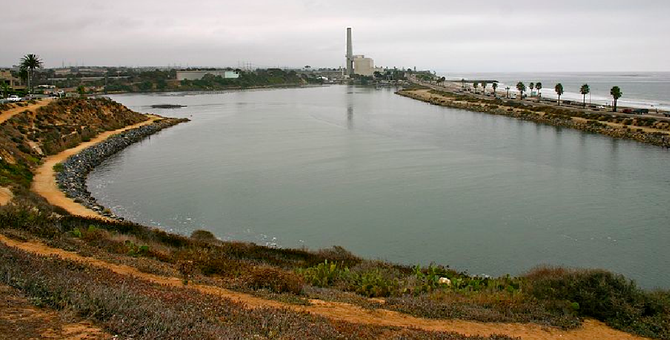 Facebook
Facebook
 X
X
 Instagram
Instagram
 TikTok
TikTok
 Youtube
Youtube

The sixth annual Carlsbad Lagoon Day takes place on Sunday, July 22.
The Agua Hedionda Lagoon Foundation (AHLF) celebrates the anniversary of the formal declaration of eradication of Caulerpa taxifolia with a walk/run and community gathering at the Agua Hedionda Lagoon Foundation Discovery Center each year.
First detected in the lagoon in 2000, Caulerpa taxifolia is a genetically modified marine seaweed and has no predators to keep it in check if released into coastal wetlands. Developed for use in aquariums, the seaweed’s release into marine environments has been ecologically devastating to areas in the Mediterranean Sea and in Australian estuaries.
The local eradication officially ended on July 12, 2006, when the California Department of Fish and Game concluded a six-year effort of unprecedented scientific and resource agency collaboration. At stake was the unknown consequence of the invasive marine seaweed making its way out of the lagoon and establishing itself within the open coast shoreline.
In the Mediterranean, Caulerpa taxifolia has displaced fisheries and smothered reefs. In turn, boating, diving, and fishing activities have been affected. Anchor lines, fishing lines, and snorkel/scuba gear all contributed to spreading the seaweed, as only one centimeter is needed to detach, find sediment, and start growing. There is no reversing the extent of its establishment in portions of Spain, France, Tunisia, Italy, Monaco, and Croatia, in addition to wetlands extending from north of Sydney Harbor south past the border of New South Wales and Victoria.
Detection of Caulerpa taxifolia in the lagoon came about when the Encina Power Station proceeded to dredge the lagoon east of Interstate 5, which involved monitoring eelgrass health. The team of scuba-diving biologists saw the bright green seaweed and knew something was wrong.
A global network of collaboration combined with a multi-agency task team called SCCAT (Southern California Caulerpa Action Team). What emerged was a California-designed eradication technique involving the construction and placement of tarps, framed with plastic piping, covering the mapped locations of the weed; then chlorine was pumped from boats or the shoreline to kill everything under the tarp’s footprint. Over time, native eelgrass grew back.


The sixth annual Carlsbad Lagoon Day takes place on Sunday, July 22.
The Agua Hedionda Lagoon Foundation (AHLF) celebrates the anniversary of the formal declaration of eradication of Caulerpa taxifolia with a walk/run and community gathering at the Agua Hedionda Lagoon Foundation Discovery Center each year.
First detected in the lagoon in 2000, Caulerpa taxifolia is a genetically modified marine seaweed and has no predators to keep it in check if released into coastal wetlands. Developed for use in aquariums, the seaweed’s release into marine environments has been ecologically devastating to areas in the Mediterranean Sea and in Australian estuaries.
The local eradication officially ended on July 12, 2006, when the California Department of Fish and Game concluded a six-year effort of unprecedented scientific and resource agency collaboration. At stake was the unknown consequence of the invasive marine seaweed making its way out of the lagoon and establishing itself within the open coast shoreline.
In the Mediterranean, Caulerpa taxifolia has displaced fisheries and smothered reefs. In turn, boating, diving, and fishing activities have been affected. Anchor lines, fishing lines, and snorkel/scuba gear all contributed to spreading the seaweed, as only one centimeter is needed to detach, find sediment, and start growing. There is no reversing the extent of its establishment in portions of Spain, France, Tunisia, Italy, Monaco, and Croatia, in addition to wetlands extending from north of Sydney Harbor south past the border of New South Wales and Victoria.
Detection of Caulerpa taxifolia in the lagoon came about when the Encina Power Station proceeded to dredge the lagoon east of Interstate 5, which involved monitoring eelgrass health. The team of scuba-diving biologists saw the bright green seaweed and knew something was wrong.
A global network of collaboration combined with a multi-agency task team called SCCAT (Southern California Caulerpa Action Team). What emerged was a California-designed eradication technique involving the construction and placement of tarps, framed with plastic piping, covering the mapped locations of the weed; then chlorine was pumped from boats or the shoreline to kill everything under the tarp’s footprint. Over time, native eelgrass grew back.
Comments